Corporate Governance and Ethics Case Study - WorldCom Company
VerifiedAdded on 2023/06/08
|14
|4061
|74
AI Summary
This study analyzes the different theories of ethics along with the AAA model and APES 110 model and how they help guide ethical outcomes. The case of WorldCom Company is discussed, which faced ethical and fraudulent charges due to actions taken in changing their financial statements. The study discusses the different theories applied to the actions of the employees and the seven steps of the American Accounting Association (AAA) model that can be used to make ethical decisions. The APES 110 Code of Ethics for Professional Accountants is also discussed.
Contribute Materials
Your contribution can guide someone’s learning journey. Share your
documents today.
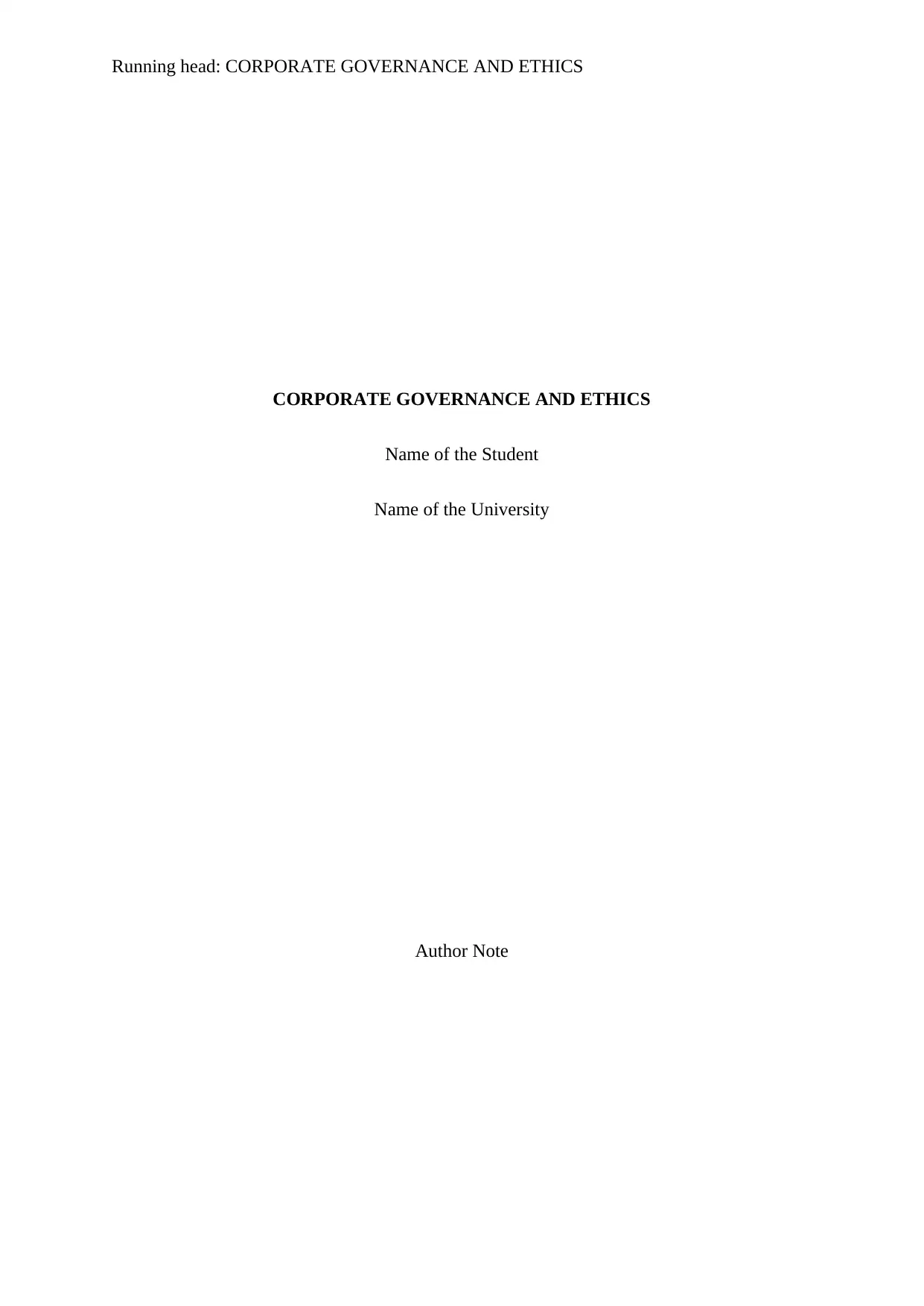
Running head: CORPORATE GOVERNANCE AND ETHICS
CORPORATE GOVERNANCE AND ETHICS
Name of the Student
Name of the University
Author Note
CORPORATE GOVERNANCE AND ETHICS
Name of the Student
Name of the University
Author Note
Secure Best Marks with AI Grader
Need help grading? Try our AI Grader for instant feedback on your assignments.
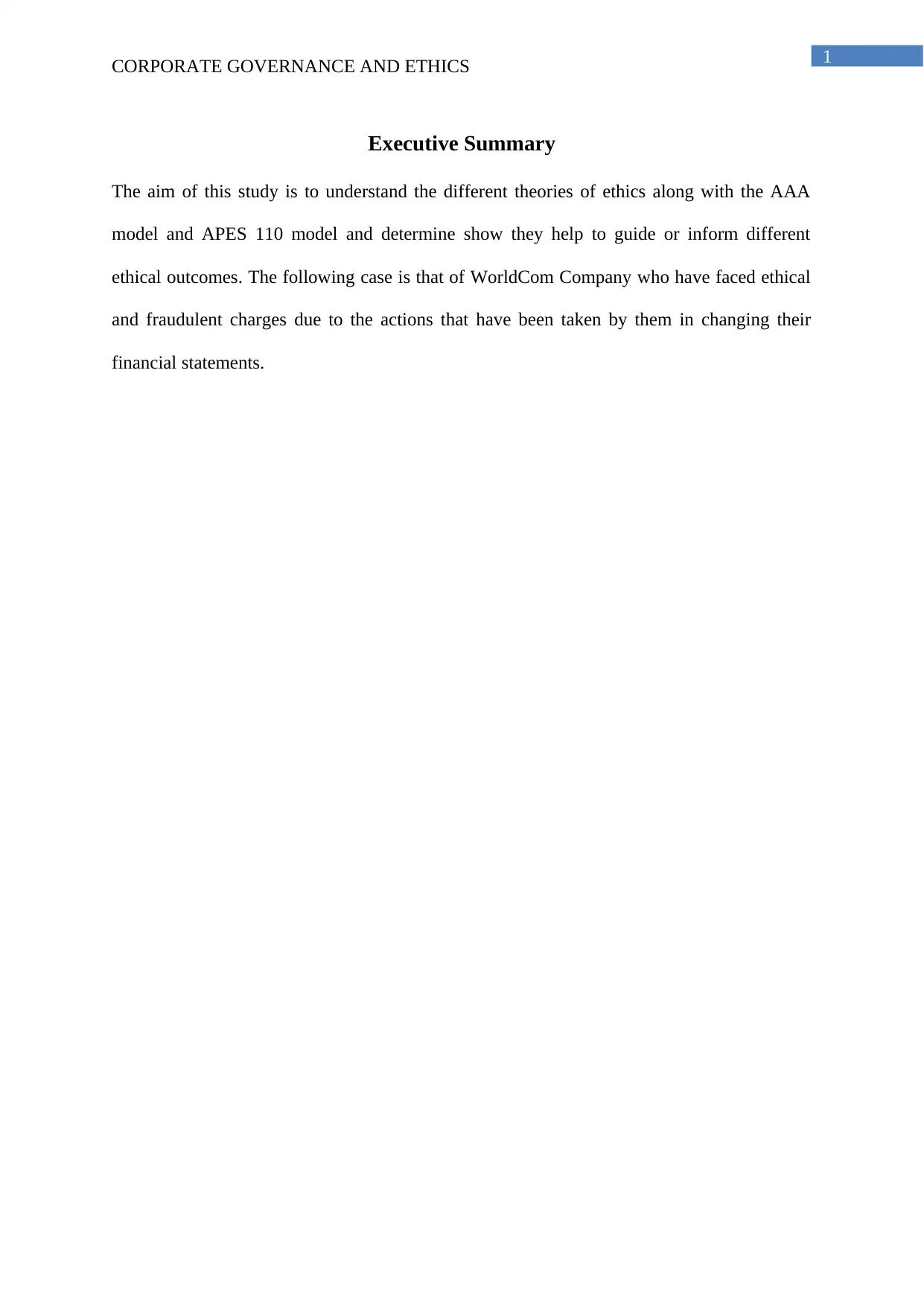
1
CORPORATE GOVERNANCE AND ETHICS
Executive Summary
The aim of this study is to understand the different theories of ethics along with the AAA
model and APES 110 model and determine show they help to guide or inform different
ethical outcomes. The following case is that of WorldCom Company who have faced ethical
and fraudulent charges due to the actions that have been taken by them in changing their
financial statements.
CORPORATE GOVERNANCE AND ETHICS
Executive Summary
The aim of this study is to understand the different theories of ethics along with the AAA
model and APES 110 model and determine show they help to guide or inform different
ethical outcomes. The following case is that of WorldCom Company who have faced ethical
and fraudulent charges due to the actions that have been taken by them in changing their
financial statements.
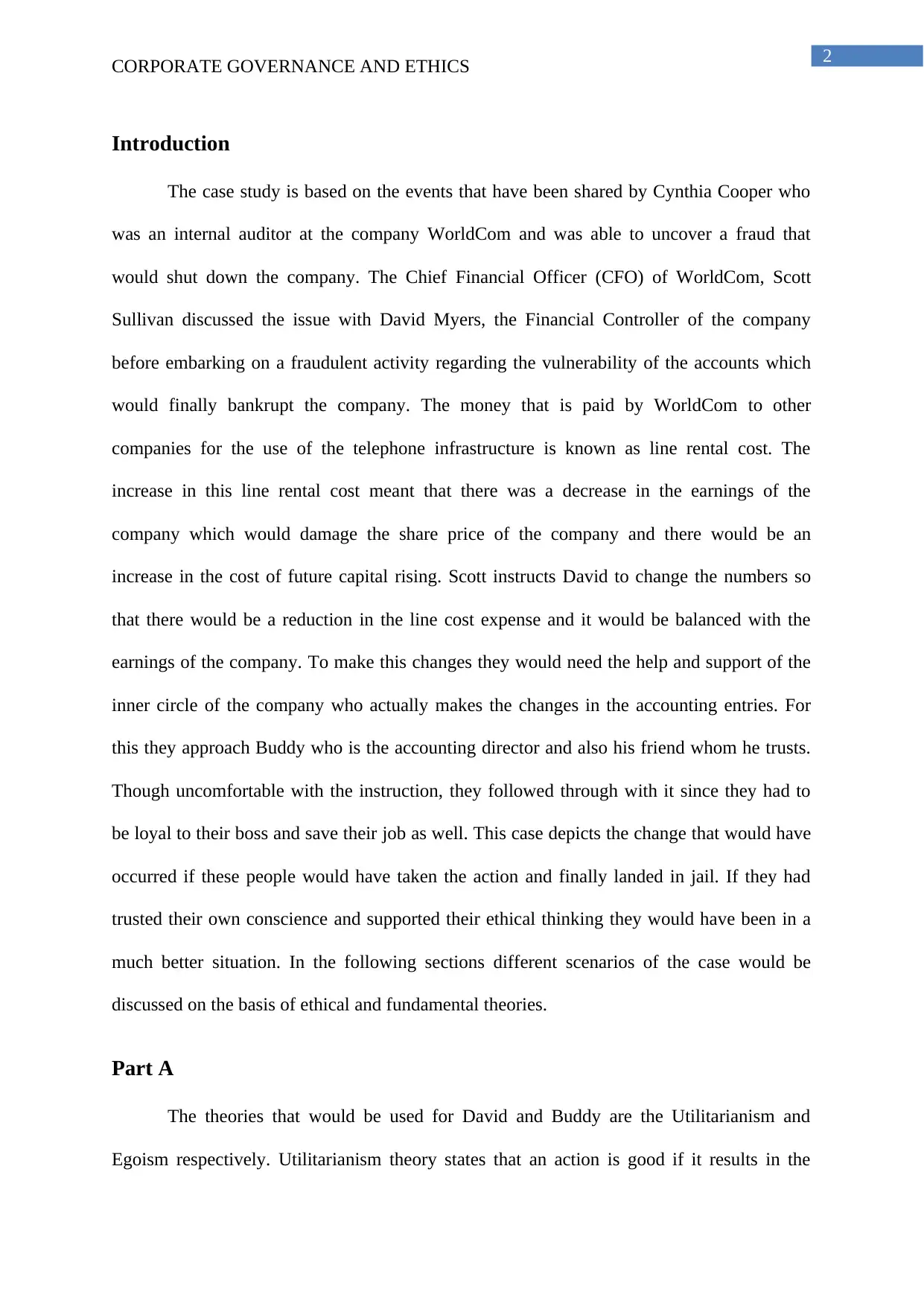
2
CORPORATE GOVERNANCE AND ETHICS
Introduction
The case study is based on the events that have been shared by Cynthia Cooper who
was an internal auditor at the company WorldCom and was able to uncover a fraud that
would shut down the company. The Chief Financial Officer (CFO) of WorldCom, Scott
Sullivan discussed the issue with David Myers, the Financial Controller of the company
before embarking on a fraudulent activity regarding the vulnerability of the accounts which
would finally bankrupt the company. The money that is paid by WorldCom to other
companies for the use of the telephone infrastructure is known as line rental cost. The
increase in this line rental cost meant that there was a decrease in the earnings of the
company which would damage the share price of the company and there would be an
increase in the cost of future capital rising. Scott instructs David to change the numbers so
that there would be a reduction in the line cost expense and it would be balanced with the
earnings of the company. To make this changes they would need the help and support of the
inner circle of the company who actually makes the changes in the accounting entries. For
this they approach Buddy who is the accounting director and also his friend whom he trusts.
Though uncomfortable with the instruction, they followed through with it since they had to
be loyal to their boss and save their job as well. This case depicts the change that would have
occurred if these people would have taken the action and finally landed in jail. If they had
trusted their own conscience and supported their ethical thinking they would have been in a
much better situation. In the following sections different scenarios of the case would be
discussed on the basis of ethical and fundamental theories.
Part A
The theories that would be used for David and Buddy are the Utilitarianism and
Egoism respectively. Utilitarianism theory states that an action is good if it results in the
CORPORATE GOVERNANCE AND ETHICS
Introduction
The case study is based on the events that have been shared by Cynthia Cooper who
was an internal auditor at the company WorldCom and was able to uncover a fraud that
would shut down the company. The Chief Financial Officer (CFO) of WorldCom, Scott
Sullivan discussed the issue with David Myers, the Financial Controller of the company
before embarking on a fraudulent activity regarding the vulnerability of the accounts which
would finally bankrupt the company. The money that is paid by WorldCom to other
companies for the use of the telephone infrastructure is known as line rental cost. The
increase in this line rental cost meant that there was a decrease in the earnings of the
company which would damage the share price of the company and there would be an
increase in the cost of future capital rising. Scott instructs David to change the numbers so
that there would be a reduction in the line cost expense and it would be balanced with the
earnings of the company. To make this changes they would need the help and support of the
inner circle of the company who actually makes the changes in the accounting entries. For
this they approach Buddy who is the accounting director and also his friend whom he trusts.
Though uncomfortable with the instruction, they followed through with it since they had to
be loyal to their boss and save their job as well. This case depicts the change that would have
occurred if these people would have taken the action and finally landed in jail. If they had
trusted their own conscience and supported their ethical thinking they would have been in a
much better situation. In the following sections different scenarios of the case would be
discussed on the basis of ethical and fundamental theories.
Part A
The theories that would be used for David and Buddy are the Utilitarianism and
Egoism respectively. Utilitarianism theory states that an action is good if it results in the
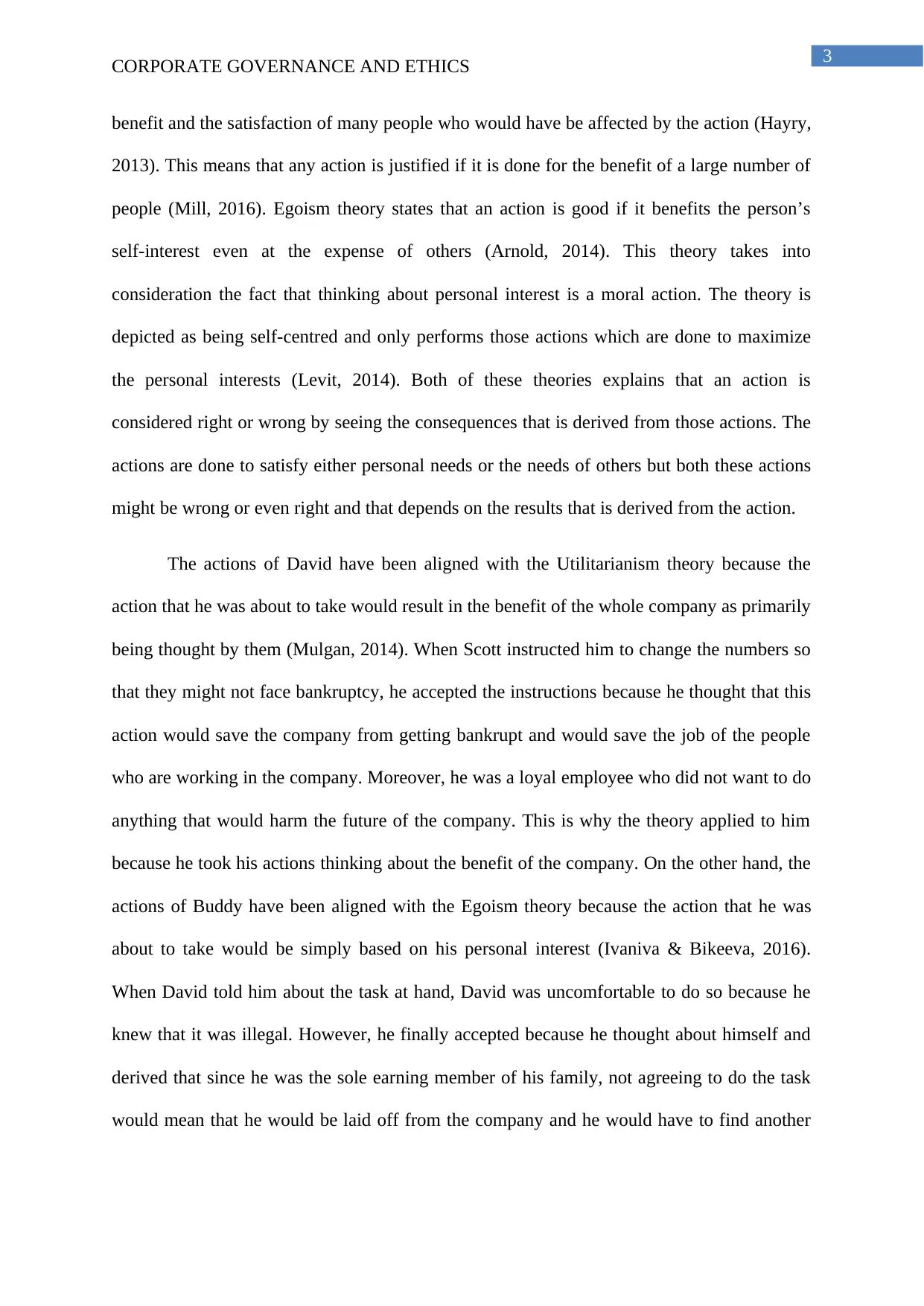
3
CORPORATE GOVERNANCE AND ETHICS
benefit and the satisfaction of many people who would have be affected by the action (Hayry,
2013). This means that any action is justified if it is done for the benefit of a large number of
people (Mill, 2016). Egoism theory states that an action is good if it benefits the person’s
self-interest even at the expense of others (Arnold, 2014). This theory takes into
consideration the fact that thinking about personal interest is a moral action. The theory is
depicted as being self-centred and only performs those actions which are done to maximize
the personal interests (Levit, 2014). Both of these theories explains that an action is
considered right or wrong by seeing the consequences that is derived from those actions. The
actions are done to satisfy either personal needs or the needs of others but both these actions
might be wrong or even right and that depends on the results that is derived from the action.
The actions of David have been aligned with the Utilitarianism theory because the
action that he was about to take would result in the benefit of the whole company as primarily
being thought by them (Mulgan, 2014). When Scott instructed him to change the numbers so
that they might not face bankruptcy, he accepted the instructions because he thought that this
action would save the company from getting bankrupt and would save the job of the people
who are working in the company. Moreover, he was a loyal employee who did not want to do
anything that would harm the future of the company. This is why the theory applied to him
because he took his actions thinking about the benefit of the company. On the other hand, the
actions of Buddy have been aligned with the Egoism theory because the action that he was
about to take would be simply based on his personal interest (Ivaniva & Bikeeva, 2016).
When David told him about the task at hand, David was uncomfortable to do so because he
knew that it was illegal. However, he finally accepted because he thought about himself and
derived that since he was the sole earning member of his family, not agreeing to do the task
would mean that he would be laid off from the company and he would have to find another
CORPORATE GOVERNANCE AND ETHICS
benefit and the satisfaction of many people who would have be affected by the action (Hayry,
2013). This means that any action is justified if it is done for the benefit of a large number of
people (Mill, 2016). Egoism theory states that an action is good if it benefits the person’s
self-interest even at the expense of others (Arnold, 2014). This theory takes into
consideration the fact that thinking about personal interest is a moral action. The theory is
depicted as being self-centred and only performs those actions which are done to maximize
the personal interests (Levit, 2014). Both of these theories explains that an action is
considered right or wrong by seeing the consequences that is derived from those actions. The
actions are done to satisfy either personal needs or the needs of others but both these actions
might be wrong or even right and that depends on the results that is derived from the action.
The actions of David have been aligned with the Utilitarianism theory because the
action that he was about to take would result in the benefit of the whole company as primarily
being thought by them (Mulgan, 2014). When Scott instructed him to change the numbers so
that they might not face bankruptcy, he accepted the instructions because he thought that this
action would save the company from getting bankrupt and would save the job of the people
who are working in the company. Moreover, he was a loyal employee who did not want to do
anything that would harm the future of the company. This is why the theory applied to him
because he took his actions thinking about the benefit of the company. On the other hand, the
actions of Buddy have been aligned with the Egoism theory because the action that he was
about to take would be simply based on his personal interest (Ivaniva & Bikeeva, 2016).
When David told him about the task at hand, David was uncomfortable to do so because he
knew that it was illegal. However, he finally accepted because he thought about himself and
derived that since he was the sole earning member of his family, not agreeing to do the task
would mean that he would be laid off from the company and he would have to find another
Secure Best Marks with AI Grader
Need help grading? Try our AI Grader for instant feedback on your assignments.
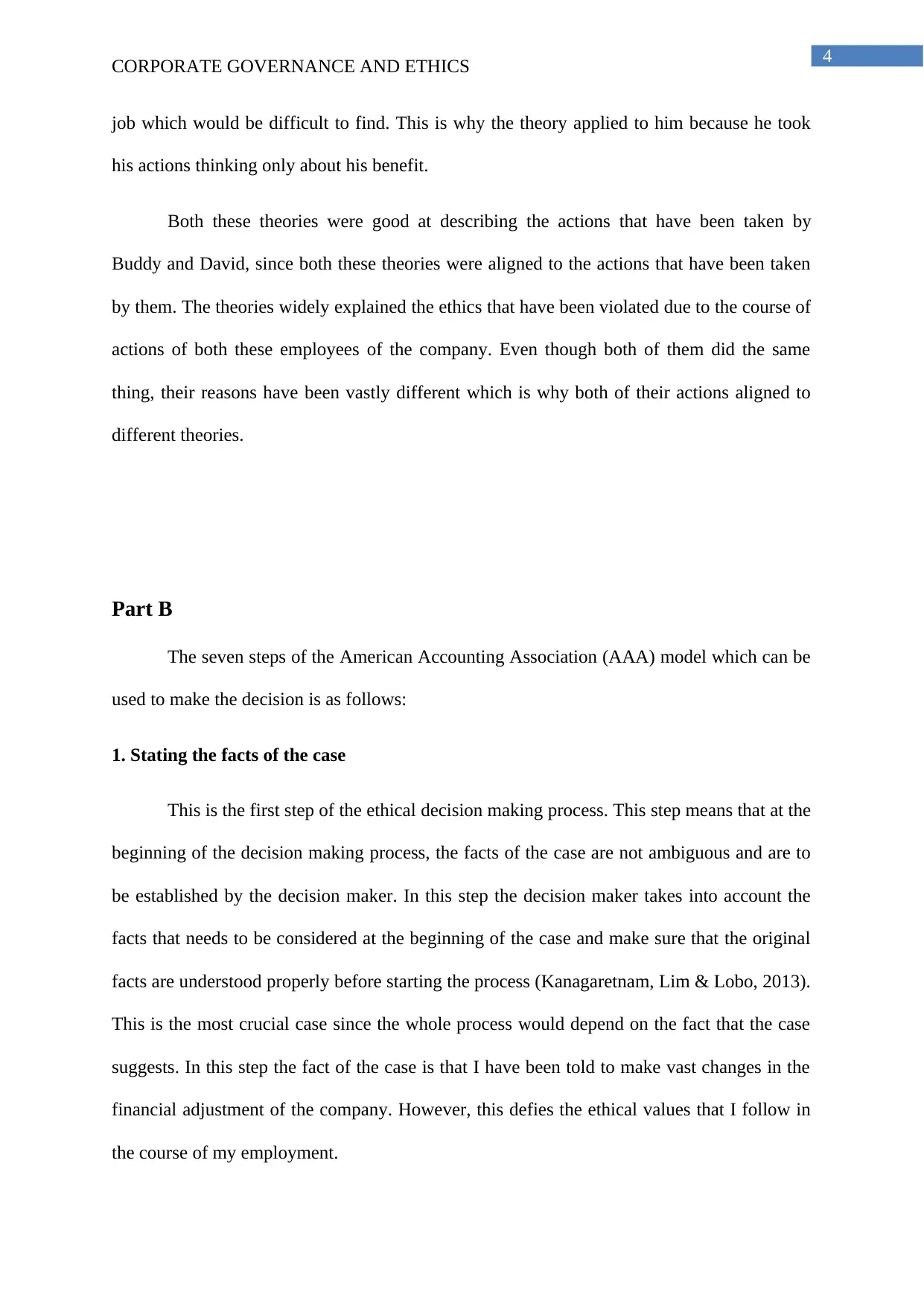
4
CORPORATE GOVERNANCE AND ETHICS
job which would be difficult to find. This is why the theory applied to him because he took
his actions thinking only about his benefit.
Both these theories were good at describing the actions that have been taken by
Buddy and David, since both these theories were aligned to the actions that have been taken
by them. The theories widely explained the ethics that have been violated due to the course of
actions of both these employees of the company. Even though both of them did the same
thing, their reasons have been vastly different which is why both of their actions aligned to
different theories.
Part B
The seven steps of the American Accounting Association (AAA) model which can be
used to make the decision is as follows:
1. Stating the facts of the case
This is the first step of the ethical decision making process. This step means that at the
beginning of the decision making process, the facts of the case are not ambiguous and are to
be established by the decision maker. In this step the decision maker takes into account the
facts that needs to be considered at the beginning of the case and make sure that the original
facts are understood properly before starting the process (Kanagaretnam, Lim & Lobo, 2013).
This is the most crucial case since the whole process would depend on the fact that the case
suggests. In this step the fact of the case is that I have been told to make vast changes in the
financial adjustment of the company. However, this defies the ethical values that I follow in
the course of my employment.
CORPORATE GOVERNANCE AND ETHICS
job which would be difficult to find. This is why the theory applied to him because he took
his actions thinking only about his benefit.
Both these theories were good at describing the actions that have been taken by
Buddy and David, since both these theories were aligned to the actions that have been taken
by them. The theories widely explained the ethics that have been violated due to the course of
actions of both these employees of the company. Even though both of them did the same
thing, their reasons have been vastly different which is why both of their actions aligned to
different theories.
Part B
The seven steps of the American Accounting Association (AAA) model which can be
used to make the decision is as follows:
1. Stating the facts of the case
This is the first step of the ethical decision making process. This step means that at the
beginning of the decision making process, the facts of the case are not ambiguous and are to
be established by the decision maker. In this step the decision maker takes into account the
facts that needs to be considered at the beginning of the case and make sure that the original
facts are understood properly before starting the process (Kanagaretnam, Lim & Lobo, 2013).
This is the most crucial case since the whole process would depend on the fact that the case
suggests. In this step the fact of the case is that I have been told to make vast changes in the
financial adjustment of the company. However, this defies the ethical values that I follow in
the course of my employment.
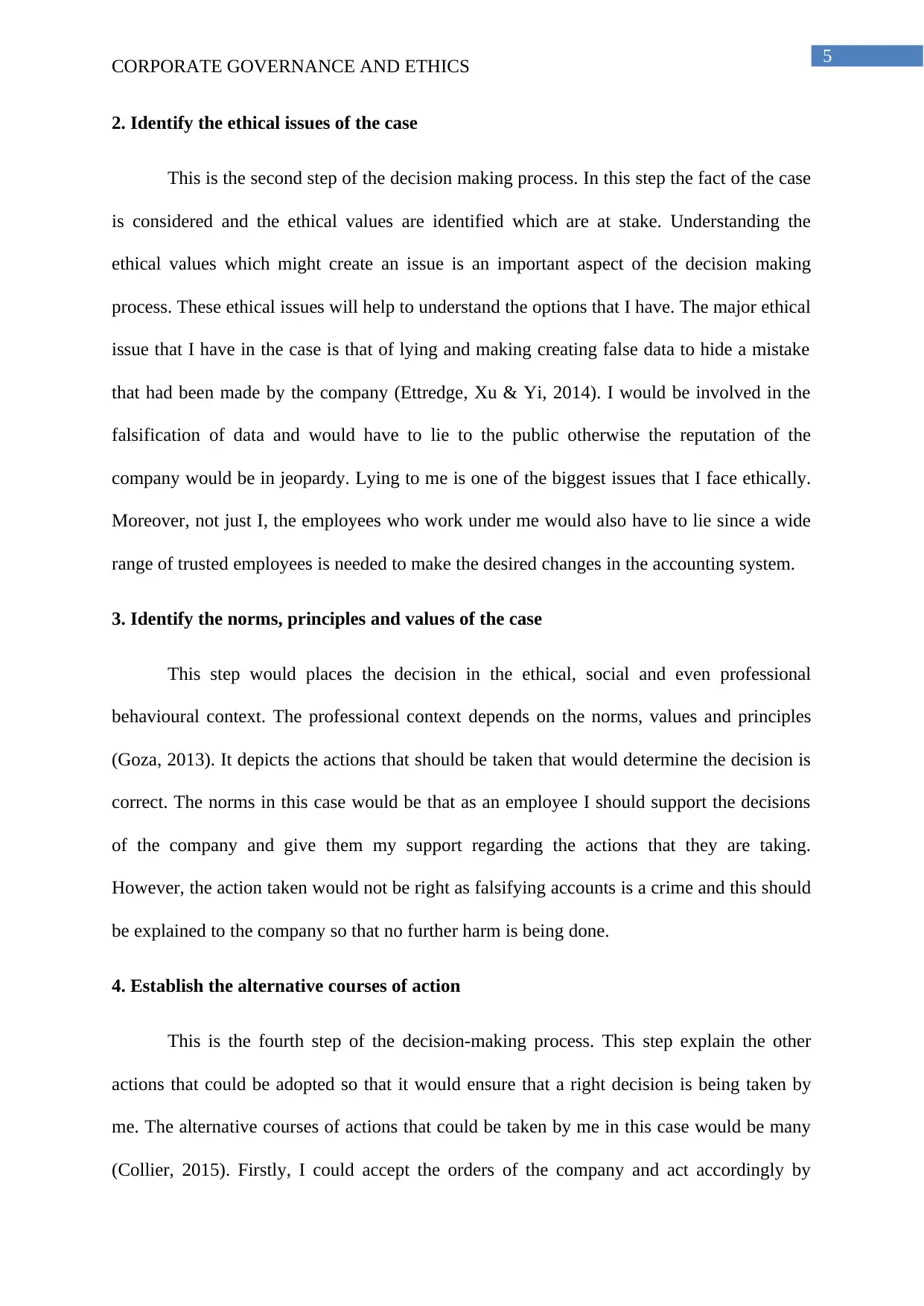
5
CORPORATE GOVERNANCE AND ETHICS
2. Identify the ethical issues of the case
This is the second step of the decision making process. In this step the fact of the case
is considered and the ethical values are identified which are at stake. Understanding the
ethical values which might create an issue is an important aspect of the decision making
process. These ethical issues will help to understand the options that I have. The major ethical
issue that I have in the case is that of lying and making creating false data to hide a mistake
that had been made by the company (Ettredge, Xu & Yi, 2014). I would be involved in the
falsification of data and would have to lie to the public otherwise the reputation of the
company would be in jeopardy. Lying to me is one of the biggest issues that I face ethically.
Moreover, not just I, the employees who work under me would also have to lie since a wide
range of trusted employees is needed to make the desired changes in the accounting system.
3. Identify the norms, principles and values of the case
This step would places the decision in the ethical, social and even professional
behavioural context. The professional context depends on the norms, values and principles
(Goza, 2013). It depicts the actions that should be taken that would determine the decision is
correct. The norms in this case would be that as an employee I should support the decisions
of the company and give them my support regarding the actions that they are taking.
However, the action taken would not be right as falsifying accounts is a crime and this should
be explained to the company so that no further harm is being done.
4. Establish the alternative courses of action
This is the fourth step of the decision-making process. This step explain the other
actions that could be adopted so that it would ensure that a right decision is being taken by
me. The alternative courses of actions that could be taken by me in this case would be many
(Collier, 2015). Firstly, I could accept the orders of the company and act accordingly by
CORPORATE GOVERNANCE AND ETHICS
2. Identify the ethical issues of the case
This is the second step of the decision making process. In this step the fact of the case
is considered and the ethical values are identified which are at stake. Understanding the
ethical values which might create an issue is an important aspect of the decision making
process. These ethical issues will help to understand the options that I have. The major ethical
issue that I have in the case is that of lying and making creating false data to hide a mistake
that had been made by the company (Ettredge, Xu & Yi, 2014). I would be involved in the
falsification of data and would have to lie to the public otherwise the reputation of the
company would be in jeopardy. Lying to me is one of the biggest issues that I face ethically.
Moreover, not just I, the employees who work under me would also have to lie since a wide
range of trusted employees is needed to make the desired changes in the accounting system.
3. Identify the norms, principles and values of the case
This step would places the decision in the ethical, social and even professional
behavioural context. The professional context depends on the norms, values and principles
(Goza, 2013). It depicts the actions that should be taken that would determine the decision is
correct. The norms in this case would be that as an employee I should support the decisions
of the company and give them my support regarding the actions that they are taking.
However, the action taken would not be right as falsifying accounts is a crime and this should
be explained to the company so that no further harm is being done.
4. Establish the alternative courses of action
This is the fourth step of the decision-making process. This step explain the other
actions that could be adopted so that it would ensure that a right decision is being taken by
me. The alternative courses of actions that could be taken by me in this case would be many
(Collier, 2015). Firstly, I could accept the orders of the company and act accordingly by
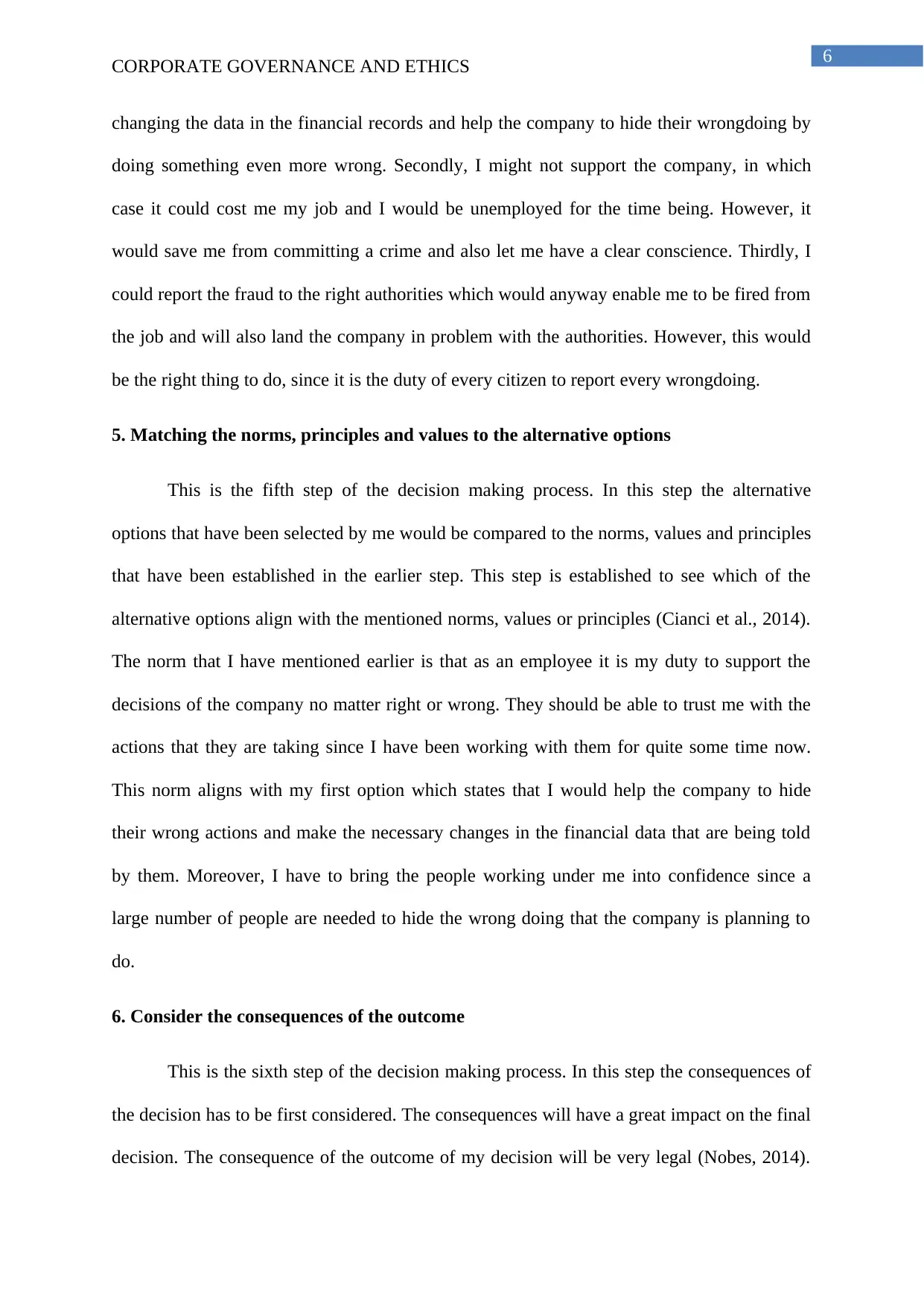
6
CORPORATE GOVERNANCE AND ETHICS
changing the data in the financial records and help the company to hide their wrongdoing by
doing something even more wrong. Secondly, I might not support the company, in which
case it could cost me my job and I would be unemployed for the time being. However, it
would save me from committing a crime and also let me have a clear conscience. Thirdly, I
could report the fraud to the right authorities which would anyway enable me to be fired from
the job and will also land the company in problem with the authorities. However, this would
be the right thing to do, since it is the duty of every citizen to report every wrongdoing.
5. Matching the norms, principles and values to the alternative options
This is the fifth step of the decision making process. In this step the alternative
options that have been selected by me would be compared to the norms, values and principles
that have been established in the earlier step. This step is established to see which of the
alternative options align with the mentioned norms, values or principles (Cianci et al., 2014).
The norm that I have mentioned earlier is that as an employee it is my duty to support the
decisions of the company no matter right or wrong. They should be able to trust me with the
actions that they are taking since I have been working with them for quite some time now.
This norm aligns with my first option which states that I would help the company to hide
their wrong actions and make the necessary changes in the financial data that are being told
by them. Moreover, I have to bring the people working under me into confidence since a
large number of people are needed to hide the wrong doing that the company is planning to
do.
6. Consider the consequences of the outcome
This is the sixth step of the decision making process. In this step the consequences of
the decision has to be first considered. The consequences will have a great impact on the final
decision. The consequence of the outcome of my decision will be very legal (Nobes, 2014).
CORPORATE GOVERNANCE AND ETHICS
changing the data in the financial records and help the company to hide their wrongdoing by
doing something even more wrong. Secondly, I might not support the company, in which
case it could cost me my job and I would be unemployed for the time being. However, it
would save me from committing a crime and also let me have a clear conscience. Thirdly, I
could report the fraud to the right authorities which would anyway enable me to be fired from
the job and will also land the company in problem with the authorities. However, this would
be the right thing to do, since it is the duty of every citizen to report every wrongdoing.
5. Matching the norms, principles and values to the alternative options
This is the fifth step of the decision making process. In this step the alternative
options that have been selected by me would be compared to the norms, values and principles
that have been established in the earlier step. This step is established to see which of the
alternative options align with the mentioned norms, values or principles (Cianci et al., 2014).
The norm that I have mentioned earlier is that as an employee it is my duty to support the
decisions of the company no matter right or wrong. They should be able to trust me with the
actions that they are taking since I have been working with them for quite some time now.
This norm aligns with my first option which states that I would help the company to hide
their wrong actions and make the necessary changes in the financial data that are being told
by them. Moreover, I have to bring the people working under me into confidence since a
large number of people are needed to hide the wrong doing that the company is planning to
do.
6. Consider the consequences of the outcome
This is the sixth step of the decision making process. In this step the consequences of
the decision has to be first considered. The consequences will have a great impact on the final
decision. The consequence of the outcome of my decision will be very legal (Nobes, 2014).
Paraphrase This Document
Need a fresh take? Get an instant paraphrase of this document with our AI Paraphraser
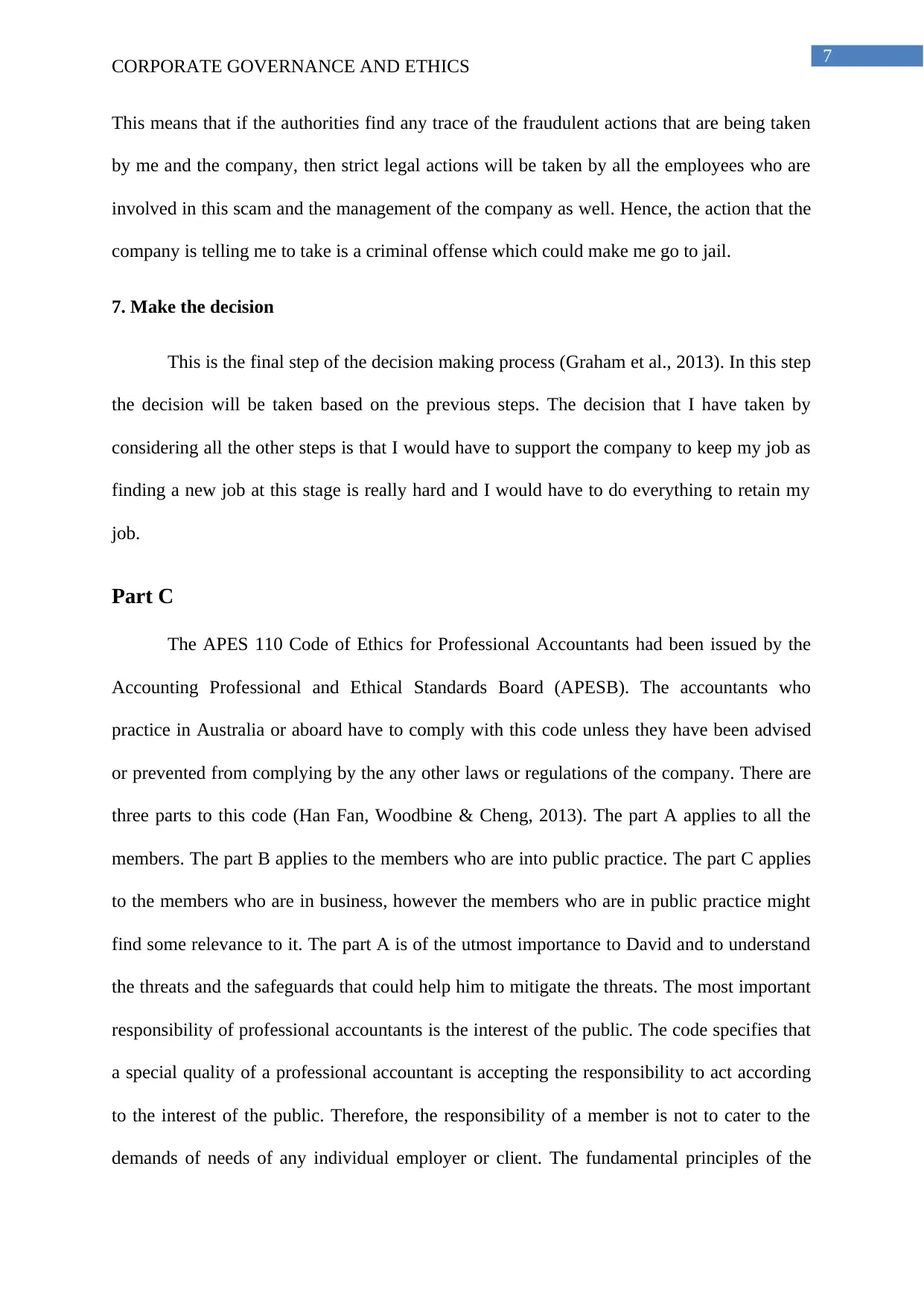
7
CORPORATE GOVERNANCE AND ETHICS
This means that if the authorities find any trace of the fraudulent actions that are being taken
by me and the company, then strict legal actions will be taken by all the employees who are
involved in this scam and the management of the company as well. Hence, the action that the
company is telling me to take is a criminal offense which could make me go to jail.
7. Make the decision
This is the final step of the decision making process (Graham et al., 2013). In this step
the decision will be taken based on the previous steps. The decision that I have taken by
considering all the other steps is that I would have to support the company to keep my job as
finding a new job at this stage is really hard and I would have to do everything to retain my
job.
Part C
The APES 110 Code of Ethics for Professional Accountants had been issued by the
Accounting Professional and Ethical Standards Board (APESB). The accountants who
practice in Australia or aboard have to comply with this code unless they have been advised
or prevented from complying by the any other laws or regulations of the company. There are
three parts to this code (Han Fan, Woodbine & Cheng, 2013). The part A applies to all the
members. The part B applies to the members who are into public practice. The part C applies
to the members who are in business, however the members who are in public practice might
find some relevance to it. The part A is of the utmost importance to David and to understand
the threats and the safeguards that could help him to mitigate the threats. The most important
responsibility of professional accountants is the interest of the public. The code specifies that
a special quality of a professional accountant is accepting the responsibility to act according
to the interest of the public. Therefore, the responsibility of a member is not to cater to the
demands of needs of any individual employer or client. The fundamental principles of the
CORPORATE GOVERNANCE AND ETHICS
This means that if the authorities find any trace of the fraudulent actions that are being taken
by me and the company, then strict legal actions will be taken by all the employees who are
involved in this scam and the management of the company as well. Hence, the action that the
company is telling me to take is a criminal offense which could make me go to jail.
7. Make the decision
This is the final step of the decision making process (Graham et al., 2013). In this step
the decision will be taken based on the previous steps. The decision that I have taken by
considering all the other steps is that I would have to support the company to keep my job as
finding a new job at this stage is really hard and I would have to do everything to retain my
job.
Part C
The APES 110 Code of Ethics for Professional Accountants had been issued by the
Accounting Professional and Ethical Standards Board (APESB). The accountants who
practice in Australia or aboard have to comply with this code unless they have been advised
or prevented from complying by the any other laws or regulations of the company. There are
three parts to this code (Han Fan, Woodbine & Cheng, 2013). The part A applies to all the
members. The part B applies to the members who are into public practice. The part C applies
to the members who are in business, however the members who are in public practice might
find some relevance to it. The part A is of the utmost importance to David and to understand
the threats and the safeguards that could help him to mitigate the threats. The most important
responsibility of professional accountants is the interest of the public. The code specifies that
a special quality of a professional accountant is accepting the responsibility to act according
to the interest of the public. Therefore, the responsibility of a member is not to cater to the
demands of needs of any individual employer or client. The fundamental principles of the
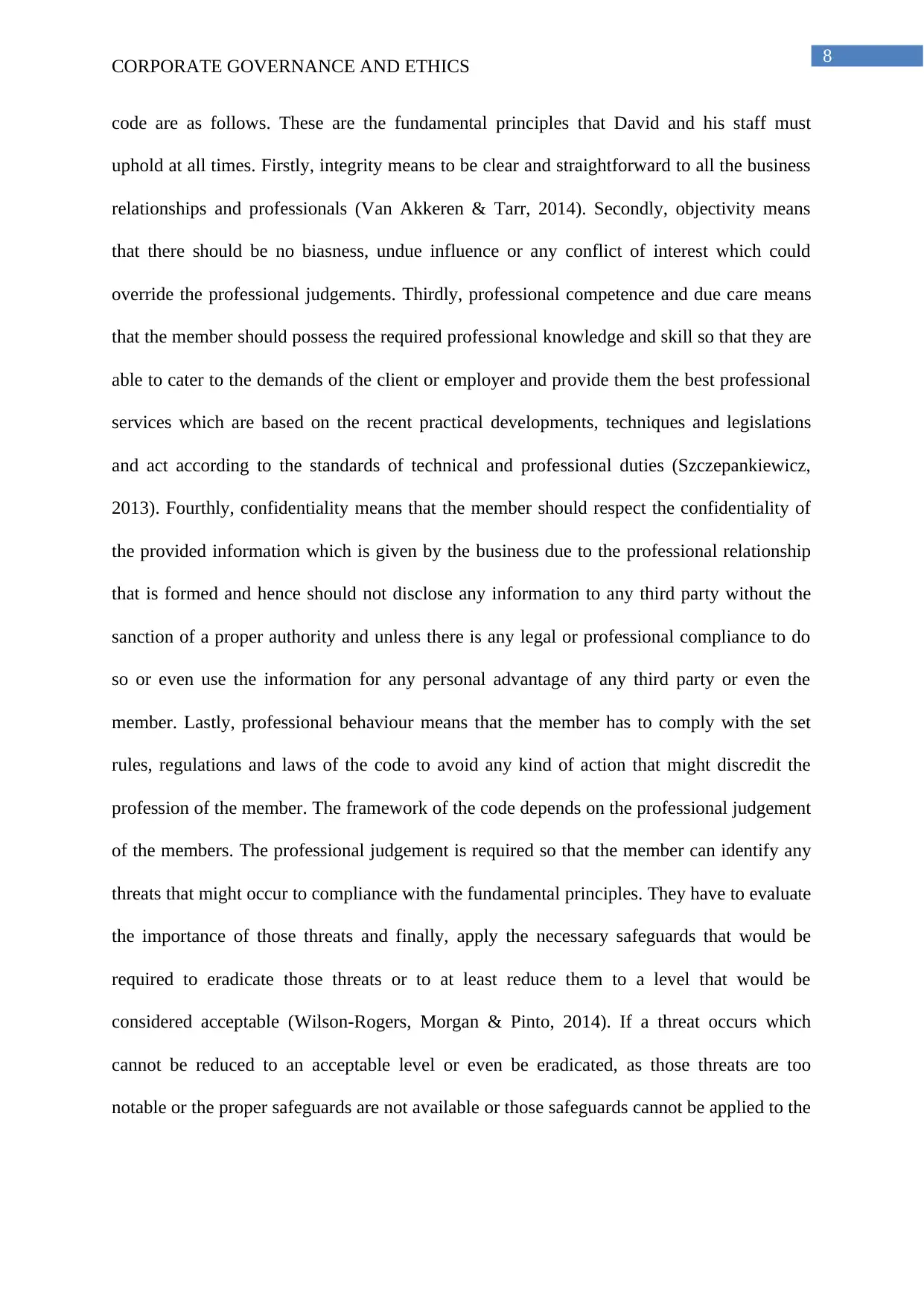
8
CORPORATE GOVERNANCE AND ETHICS
code are as follows. These are the fundamental principles that David and his staff must
uphold at all times. Firstly, integrity means to be clear and straightforward to all the business
relationships and professionals (Van Akkeren & Tarr, 2014). Secondly, objectivity means
that there should be no biasness, undue influence or any conflict of interest which could
override the professional judgements. Thirdly, professional competence and due care means
that the member should possess the required professional knowledge and skill so that they are
able to cater to the demands of the client or employer and provide them the best professional
services which are based on the recent practical developments, techniques and legislations
and act according to the standards of technical and professional duties (Szczepankiewicz,
2013). Fourthly, confidentiality means that the member should respect the confidentiality of
the provided information which is given by the business due to the professional relationship
that is formed and hence should not disclose any information to any third party without the
sanction of a proper authority and unless there is any legal or professional compliance to do
so or even use the information for any personal advantage of any third party or even the
member. Lastly, professional behaviour means that the member has to comply with the set
rules, regulations and laws of the code to avoid any kind of action that might discredit the
profession of the member. The framework of the code depends on the professional judgement
of the members. The professional judgement is required so that the member can identify any
threats that might occur to compliance with the fundamental principles. They have to evaluate
the importance of those threats and finally, apply the necessary safeguards that would be
required to eradicate those threats or to at least reduce them to a level that would be
considered acceptable (Wilson-Rogers, Morgan & Pinto, 2014). If a threat occurs which
cannot be reduced to an acceptable level or even be eradicated, as those threats are too
notable or the proper safeguards are not available or those safeguards cannot be applied to the
CORPORATE GOVERNANCE AND ETHICS
code are as follows. These are the fundamental principles that David and his staff must
uphold at all times. Firstly, integrity means to be clear and straightforward to all the business
relationships and professionals (Van Akkeren & Tarr, 2014). Secondly, objectivity means
that there should be no biasness, undue influence or any conflict of interest which could
override the professional judgements. Thirdly, professional competence and due care means
that the member should possess the required professional knowledge and skill so that they are
able to cater to the demands of the client or employer and provide them the best professional
services which are based on the recent practical developments, techniques and legislations
and act according to the standards of technical and professional duties (Szczepankiewicz,
2013). Fourthly, confidentiality means that the member should respect the confidentiality of
the provided information which is given by the business due to the professional relationship
that is formed and hence should not disclose any information to any third party without the
sanction of a proper authority and unless there is any legal or professional compliance to do
so or even use the information for any personal advantage of any third party or even the
member. Lastly, professional behaviour means that the member has to comply with the set
rules, regulations and laws of the code to avoid any kind of action that might discredit the
profession of the member. The framework of the code depends on the professional judgement
of the members. The professional judgement is required so that the member can identify any
threats that might occur to compliance with the fundamental principles. They have to evaluate
the importance of those threats and finally, apply the necessary safeguards that would be
required to eradicate those threats or to at least reduce them to a level that would be
considered acceptable (Wilson-Rogers, Morgan & Pinto, 2014). If a threat occurs which
cannot be reduced to an acceptable level or even be eradicated, as those threats are too
notable or the proper safeguards are not available or those safeguards cannot be applied to the
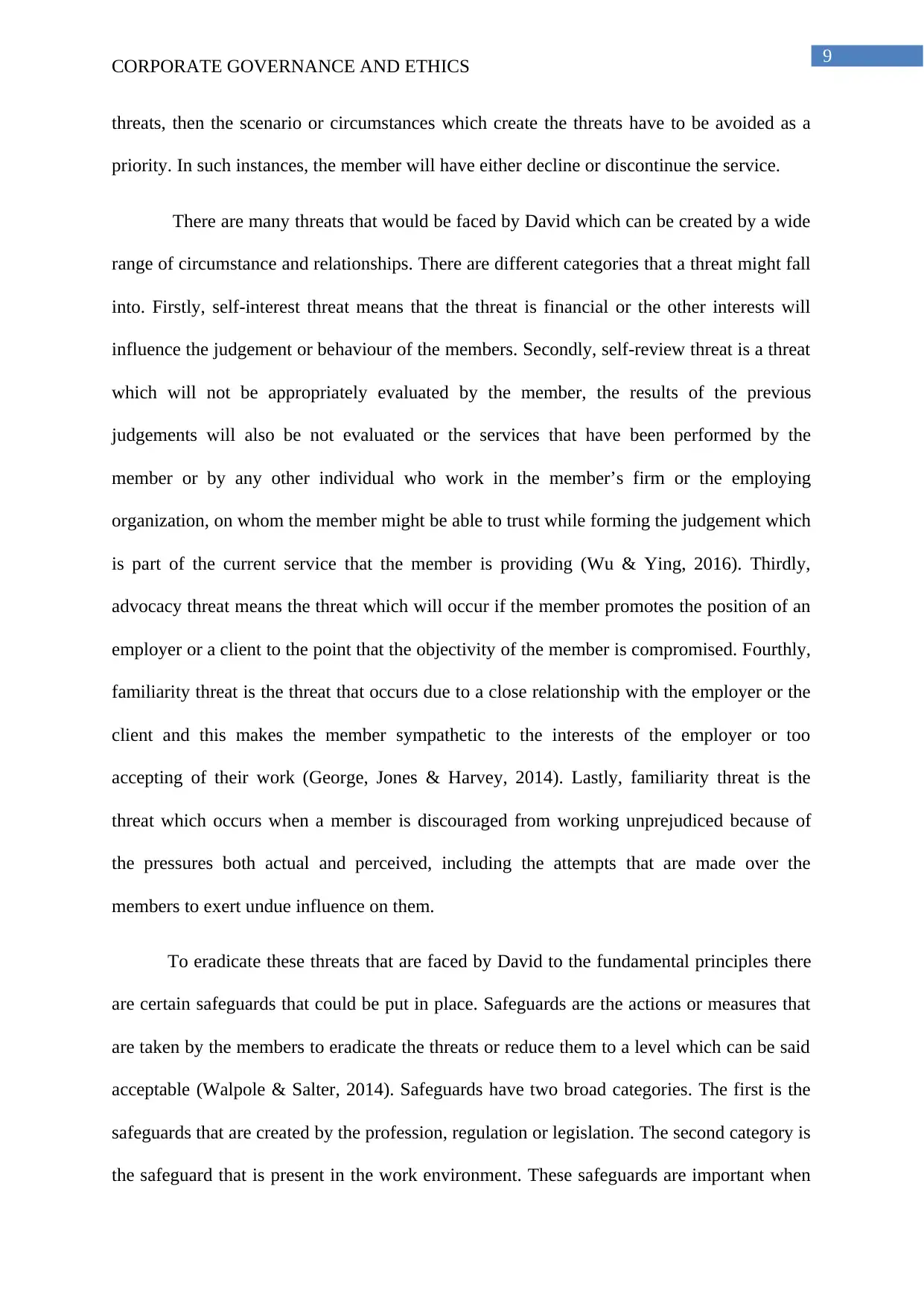
9
CORPORATE GOVERNANCE AND ETHICS
threats, then the scenario or circumstances which create the threats have to be avoided as a
priority. In such instances, the member will have either decline or discontinue the service.
There are many threats that would be faced by David which can be created by a wide
range of circumstance and relationships. There are different categories that a threat might fall
into. Firstly, self-interest threat means that the threat is financial or the other interests will
influence the judgement or behaviour of the members. Secondly, self-review threat is a threat
which will not be appropriately evaluated by the member, the results of the previous
judgements will also be not evaluated or the services that have been performed by the
member or by any other individual who work in the member’s firm or the employing
organization, on whom the member might be able to trust while forming the judgement which
is part of the current service that the member is providing (Wu & Ying, 2016). Thirdly,
advocacy threat means the threat which will occur if the member promotes the position of an
employer or a client to the point that the objectivity of the member is compromised. Fourthly,
familiarity threat is the threat that occurs due to a close relationship with the employer or the
client and this makes the member sympathetic to the interests of the employer or too
accepting of their work (George, Jones & Harvey, 2014). Lastly, familiarity threat is the
threat which occurs when a member is discouraged from working unprejudiced because of
the pressures both actual and perceived, including the attempts that are made over the
members to exert undue influence on them.
To eradicate these threats that are faced by David to the fundamental principles there
are certain safeguards that could be put in place. Safeguards are the actions or measures that
are taken by the members to eradicate the threats or reduce them to a level which can be said
acceptable (Walpole & Salter, 2014). Safeguards have two broad categories. The first is the
safeguards that are created by the profession, regulation or legislation. The second category is
the safeguard that is present in the work environment. These safeguards are important when
CORPORATE GOVERNANCE AND ETHICS
threats, then the scenario or circumstances which create the threats have to be avoided as a
priority. In such instances, the member will have either decline or discontinue the service.
There are many threats that would be faced by David which can be created by a wide
range of circumstance and relationships. There are different categories that a threat might fall
into. Firstly, self-interest threat means that the threat is financial or the other interests will
influence the judgement or behaviour of the members. Secondly, self-review threat is a threat
which will not be appropriately evaluated by the member, the results of the previous
judgements will also be not evaluated or the services that have been performed by the
member or by any other individual who work in the member’s firm or the employing
organization, on whom the member might be able to trust while forming the judgement which
is part of the current service that the member is providing (Wu & Ying, 2016). Thirdly,
advocacy threat means the threat which will occur if the member promotes the position of an
employer or a client to the point that the objectivity of the member is compromised. Fourthly,
familiarity threat is the threat that occurs due to a close relationship with the employer or the
client and this makes the member sympathetic to the interests of the employer or too
accepting of their work (George, Jones & Harvey, 2014). Lastly, familiarity threat is the
threat which occurs when a member is discouraged from working unprejudiced because of
the pressures both actual and perceived, including the attempts that are made over the
members to exert undue influence on them.
To eradicate these threats that are faced by David to the fundamental principles there
are certain safeguards that could be put in place. Safeguards are the actions or measures that
are taken by the members to eradicate the threats or reduce them to a level which can be said
acceptable (Walpole & Salter, 2014). Safeguards have two broad categories. The first is the
safeguards that are created by the profession, regulation or legislation. The second category is
the safeguard that is present in the work environment. These safeguards are important when
Secure Best Marks with AI Grader
Need help grading? Try our AI Grader for instant feedback on your assignments.
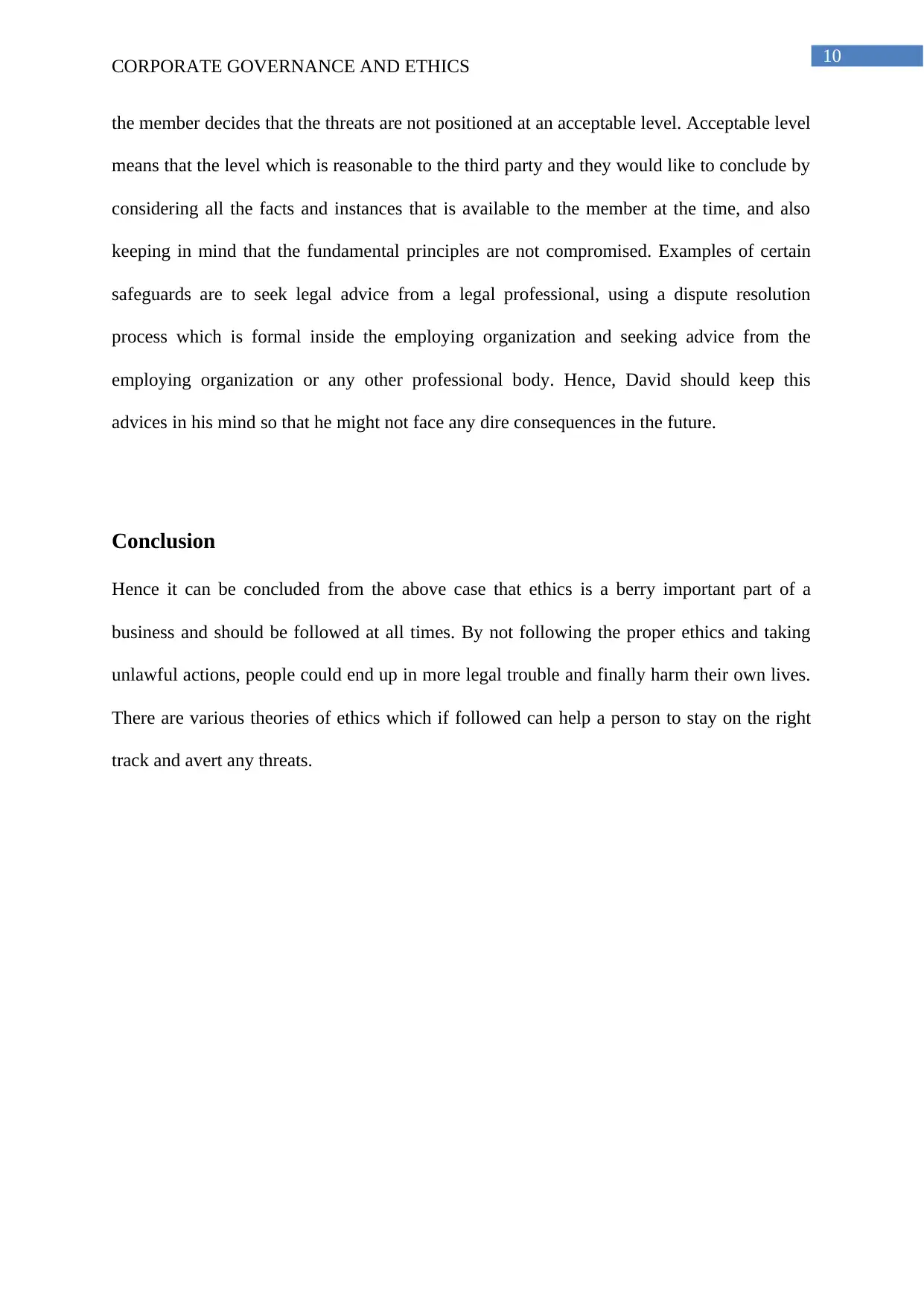
10
CORPORATE GOVERNANCE AND ETHICS
the member decides that the threats are not positioned at an acceptable level. Acceptable level
means that the level which is reasonable to the third party and they would like to conclude by
considering all the facts and instances that is available to the member at the time, and also
keeping in mind that the fundamental principles are not compromised. Examples of certain
safeguards are to seek legal advice from a legal professional, using a dispute resolution
process which is formal inside the employing organization and seeking advice from the
employing organization or any other professional body. Hence, David should keep this
advices in his mind so that he might not face any dire consequences in the future.
Conclusion
Hence it can be concluded from the above case that ethics is a berry important part of a
business and should be followed at all times. By not following the proper ethics and taking
unlawful actions, people could end up in more legal trouble and finally harm their own lives.
There are various theories of ethics which if followed can help a person to stay on the right
track and avert any threats.
CORPORATE GOVERNANCE AND ETHICS
the member decides that the threats are not positioned at an acceptable level. Acceptable level
means that the level which is reasonable to the third party and they would like to conclude by
considering all the facts and instances that is available to the member at the time, and also
keeping in mind that the fundamental principles are not compromised. Examples of certain
safeguards are to seek legal advice from a legal professional, using a dispute resolution
process which is formal inside the employing organization and seeking advice from the
employing organization or any other professional body. Hence, David should keep this
advices in his mind so that he might not face any dire consequences in the future.
Conclusion
Hence it can be concluded from the above case that ethics is a berry important part of a
business and should be followed at all times. By not following the proper ethics and taking
unlawful actions, people could end up in more legal trouble and finally harm their own lives.
There are various theories of ethics which if followed can help a person to stay on the right
track and avert any threats.
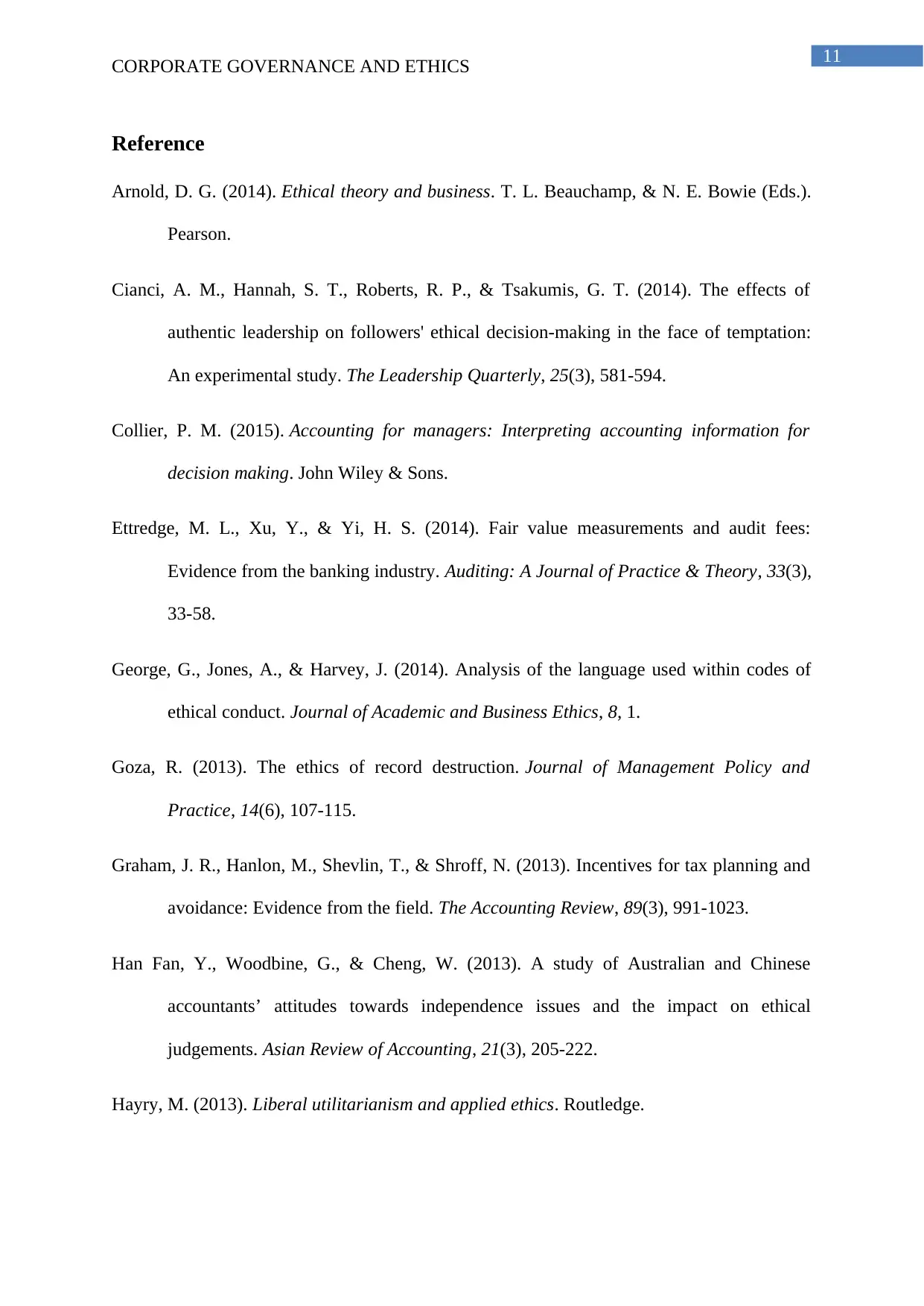
11
CORPORATE GOVERNANCE AND ETHICS
Reference
Arnold, D. G. (2014). Ethical theory and business. T. L. Beauchamp, & N. E. Bowie (Eds.).
Pearson.
Cianci, A. M., Hannah, S. T., Roberts, R. P., & Tsakumis, G. T. (2014). The effects of
authentic leadership on followers' ethical decision-making in the face of temptation:
An experimental study. The Leadership Quarterly, 25(3), 581-594.
Collier, P. M. (2015). Accounting for managers: Interpreting accounting information for
decision making. John Wiley & Sons.
Ettredge, M. L., Xu, Y., & Yi, H. S. (2014). Fair value measurements and audit fees:
Evidence from the banking industry. Auditing: A Journal of Practice & Theory, 33(3),
33-58.
George, G., Jones, A., & Harvey, J. (2014). Analysis of the language used within codes of
ethical conduct. Journal of Academic and Business Ethics, 8, 1.
Goza, R. (2013). The ethics of record destruction. Journal of Management Policy and
Practice, 14(6), 107-115.
Graham, J. R., Hanlon, M., Shevlin, T., & Shroff, N. (2013). Incentives for tax planning and
avoidance: Evidence from the field. The Accounting Review, 89(3), 991-1023.
Han Fan, Y., Woodbine, G., & Cheng, W. (2013). A study of Australian and Chinese
accountants’ attitudes towards independence issues and the impact on ethical
judgements. Asian Review of Accounting, 21(3), 205-222.
Hayry, M. (2013). Liberal utilitarianism and applied ethics. Routledge.
CORPORATE GOVERNANCE AND ETHICS
Reference
Arnold, D. G. (2014). Ethical theory and business. T. L. Beauchamp, & N. E. Bowie (Eds.).
Pearson.
Cianci, A. M., Hannah, S. T., Roberts, R. P., & Tsakumis, G. T. (2014). The effects of
authentic leadership on followers' ethical decision-making in the face of temptation:
An experimental study. The Leadership Quarterly, 25(3), 581-594.
Collier, P. M. (2015). Accounting for managers: Interpreting accounting information for
decision making. John Wiley & Sons.
Ettredge, M. L., Xu, Y., & Yi, H. S. (2014). Fair value measurements and audit fees:
Evidence from the banking industry. Auditing: A Journal of Practice & Theory, 33(3),
33-58.
George, G., Jones, A., & Harvey, J. (2014). Analysis of the language used within codes of
ethical conduct. Journal of Academic and Business Ethics, 8, 1.
Goza, R. (2013). The ethics of record destruction. Journal of Management Policy and
Practice, 14(6), 107-115.
Graham, J. R., Hanlon, M., Shevlin, T., & Shroff, N. (2013). Incentives for tax planning and
avoidance: Evidence from the field. The Accounting Review, 89(3), 991-1023.
Han Fan, Y., Woodbine, G., & Cheng, W. (2013). A study of Australian and Chinese
accountants’ attitudes towards independence issues and the impact on ethical
judgements. Asian Review of Accounting, 21(3), 205-222.
Hayry, M. (2013). Liberal utilitarianism and applied ethics. Routledge.
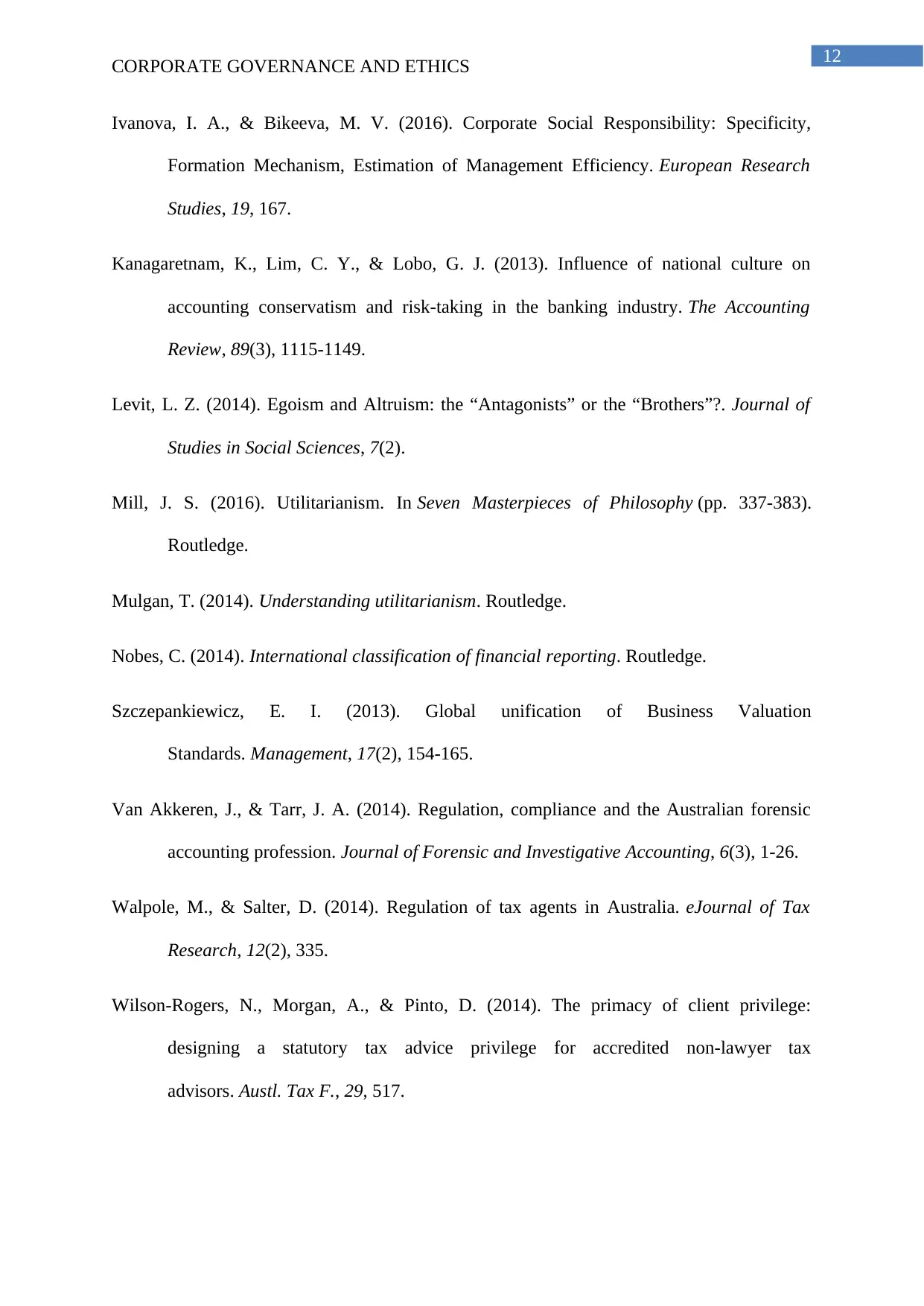
12
CORPORATE GOVERNANCE AND ETHICS
Ivanova, I. A., & Bikeeva, M. V. (2016). Corporate Social Responsibility: Specificity,
Formation Mechanism, Estimation of Management Efficiency. European Research
Studies, 19, 167.
Kanagaretnam, K., Lim, C. Y., & Lobo, G. J. (2013). Influence of national culture on
accounting conservatism and risk-taking in the banking industry. The Accounting
Review, 89(3), 1115-1149.
Levit, L. Z. (2014). Egoism and Altruism: the “Antagonists” or the “Brothers”?. Journal of
Studies in Social Sciences, 7(2).
Mill, J. S. (2016). Utilitarianism. In Seven Masterpieces of Philosophy (pp. 337-383).
Routledge.
Mulgan, T. (2014). Understanding utilitarianism. Routledge.
Nobes, C. (2014). International classification of financial reporting. Routledge.
Szczepankiewicz, E. I. (2013). Global unification of Business Valuation
Standards. Management, 17(2), 154-165.
Van Akkeren, J., & Tarr, J. A. (2014). Regulation, compliance and the Australian forensic
accounting profession. Journal of Forensic and Investigative Accounting, 6(3), 1-26.
Walpole, M., & Salter, D. (2014). Regulation of tax agents in Australia. eJournal of Tax
Research, 12(2), 335.
Wilson-Rogers, N., Morgan, A., & Pinto, D. (2014). The primacy of client privilege:
designing a statutory tax advice privilege for accredited non-lawyer tax
advisors. Austl. Tax F., 29, 517.
CORPORATE GOVERNANCE AND ETHICS
Ivanova, I. A., & Bikeeva, M. V. (2016). Corporate Social Responsibility: Specificity,
Formation Mechanism, Estimation of Management Efficiency. European Research
Studies, 19, 167.
Kanagaretnam, K., Lim, C. Y., & Lobo, G. J. (2013). Influence of national culture on
accounting conservatism and risk-taking in the banking industry. The Accounting
Review, 89(3), 1115-1149.
Levit, L. Z. (2014). Egoism and Altruism: the “Antagonists” or the “Brothers”?. Journal of
Studies in Social Sciences, 7(2).
Mill, J. S. (2016). Utilitarianism. In Seven Masterpieces of Philosophy (pp. 337-383).
Routledge.
Mulgan, T. (2014). Understanding utilitarianism. Routledge.
Nobes, C. (2014). International classification of financial reporting. Routledge.
Szczepankiewicz, E. I. (2013). Global unification of Business Valuation
Standards. Management, 17(2), 154-165.
Van Akkeren, J., & Tarr, J. A. (2014). Regulation, compliance and the Australian forensic
accounting profession. Journal of Forensic and Investigative Accounting, 6(3), 1-26.
Walpole, M., & Salter, D. (2014). Regulation of tax agents in Australia. eJournal of Tax
Research, 12(2), 335.
Wilson-Rogers, N., Morgan, A., & Pinto, D. (2014). The primacy of client privilege:
designing a statutory tax advice privilege for accredited non-lawyer tax
advisors. Austl. Tax F., 29, 517.
Paraphrase This Document
Need a fresh take? Get an instant paraphrase of this document with our AI Paraphraser
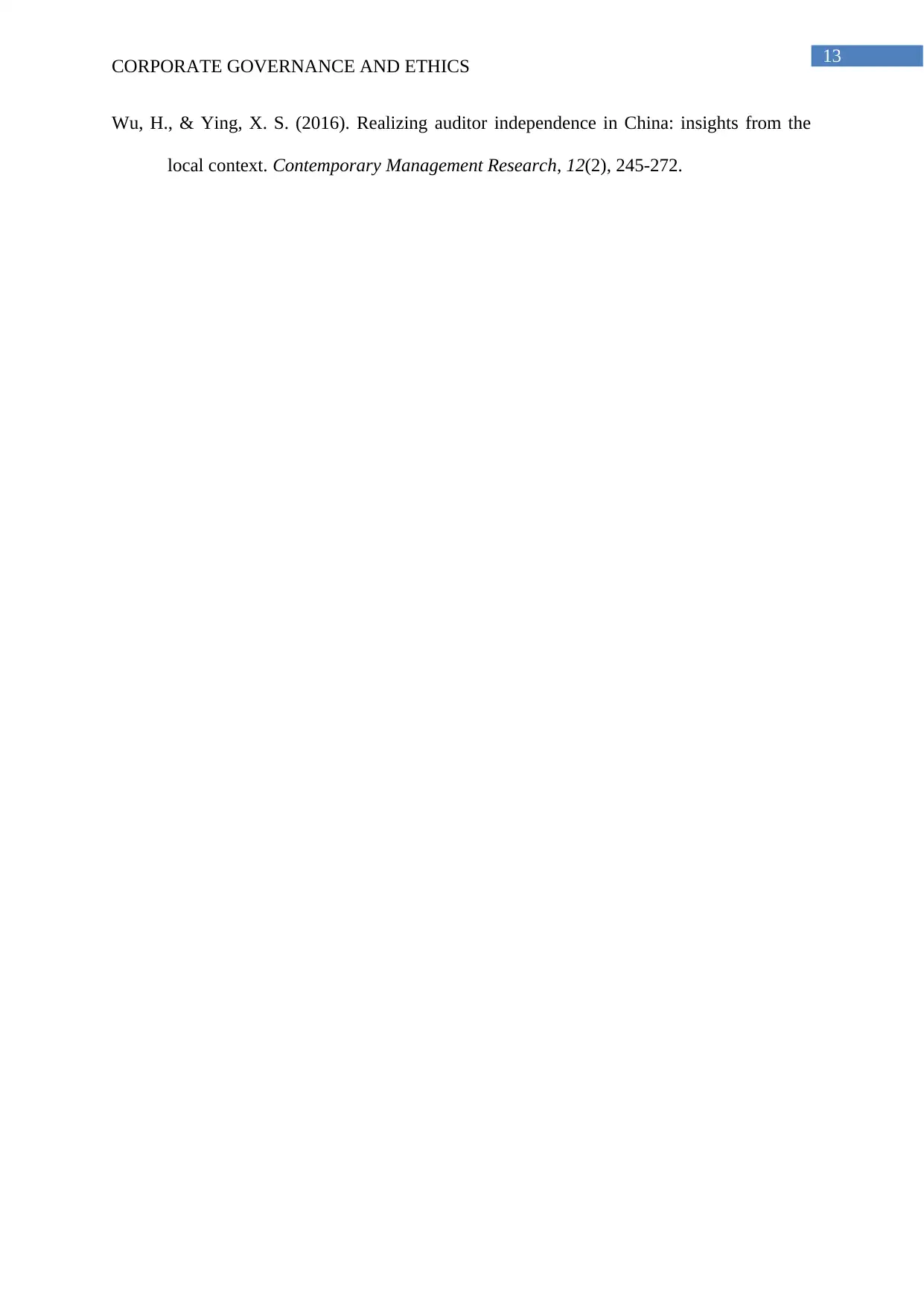
13
CORPORATE GOVERNANCE AND ETHICS
Wu, H., & Ying, X. S. (2016). Realizing auditor independence in China: insights from the
local context. Contemporary Management Research, 12(2), 245-272.
CORPORATE GOVERNANCE AND ETHICS
Wu, H., & Ying, X. S. (2016). Realizing auditor independence in China: insights from the
local context. Contemporary Management Research, 12(2), 245-272.
1 out of 14
Related Documents
Your All-in-One AI-Powered Toolkit for Academic Success.
+13062052269
info@desklib.com
Available 24*7 on WhatsApp / Email
![[object Object]](/_next/static/media/star-bottom.7253800d.svg)
Unlock your academic potential
© 2024 | Zucol Services PVT LTD | All rights reserved.




